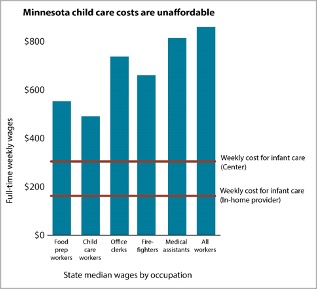A bipartisan task force of Minnesota legislators heard from parents, providers and employers about the challenges that a lack of affordable, accessible child care presents to their communities. Their findings were summarized in a recent report. The juxtaposition of two presentations mentioned in the report demonstrate the central problem in the child care market: too many parents can’t afford to pay more, and too many providers can’t afford to charge less.
In August, First Children’s Finance came before the task force to describe what they’ve learned from their child care provider clients. First Children’s Finance provides business-development and financial assistance to child care providers across the state and nation. They estimated that half of the family child care providers in Minnesota earn less than $8 per hour, and presented case studies that highlight the thin margins of many child care centers’ operations.
At the same hearing, Child Care Aware of Minnesota presented compelling evidence that the cost of child care is out of reach for many Minnesota families. They found that the average cost for an infant in a child care center — $14,826 per year — represented more than half of the median income for a single-parent family in Minnesota ($27,093). And even at the less-expensive family child care providers, the $8,033 price tag of a year’s worth of infant care would be a significant burden for parents who are paid low wages.

Source: Minnesota Budget Project analysis of U.S. Bureau of Labor Statistics and Child Care Aware data.
With such strong evidence in front of them, it is not surprising that the task force recommended increasing the rates that Minnesota’s Child Care Assistance Program (CCAP) pays to child care providers, and increasing the number of families able to access CCAP through Basic Sliding Fee.
The evidence of low pay and thin margins in the industry make a strong case for raising higher reimbursement rates. When a family participates in CCAP, their child care provider receives a reimbursement from their county based on their children’s ages, the type of care environment, and location. The state’s payments to providers are out of date, and are often set far below market rates. This means providers may lose money when they choose to serve families using Basic Sliding Fee. The task force’s recommendation to increase provider rates are thus likely to increase parental choice.
The large gap between the cost of providing child care and the earnings of families surviving on low wages point to the importance of the task force’s recommendation to increase access to Basic Sliding Fee Child Care Assistance. The state allocates a fixed amount of money to pay for Basic Sliding Fee each year; however, that amount is far too low to cover all eligible families. As a result, Basic Sliding Fee has a 5,000 family waiting list and is currently serving about 4,000 fewer families than it did in FY 2003.
The Minnesota Budget Project and our partners in the Kids Can’t Wait Coalition have been advancing these two recommendations at the Legislature in House File 723 and Senate File 823. These bills would increase provider rates to reflect the most recent market survey data and allocate additional money to serve families through Basic Sliding Fee. By enacting this legislation this year, policymakers would be responding directly to the statewide voices as reflected in the task force report.
By Ben Horowitz